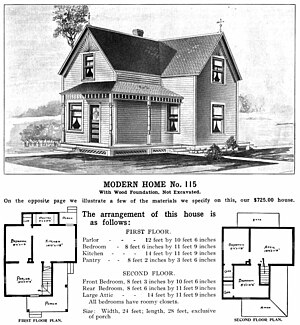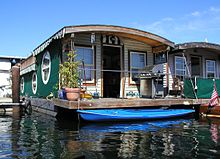Home

A home or domicile is a dwelling-place used as a permanent or semi-permanent residence for an individual, family, household or several families in a tribe. It is often a house, apartment, or other building, or alternatively a mobile home, houseboat, yurt or any other portable shelter. Homes typically provide areas and facilities for sleeping, preparing food, eating and hygiene. Larger groups may live in a nursing home, children's home, convent or any similar institution. A homestead also includes agricultural land and facilities for domesticated animals. Where more secure dwellings are not available, people may live in the informal and sometimes illegal shacks found in slums and shanty towns. More generally, "home" may be considered to be a geographic area, such as a town, village, suburb, city, or country.
Transitory accommodation in a treatment facility for a few weeks is not normally considered permanent enough to replace a more stable location as 'home'.[citation needed] In 2005, 100 million people worldwide were estimated to be homeless.
History
Buildings such as huts and longhouses have been used for living since the late Neolithic.[1]
Types
Buildings

A house is a building that functions as a home for humans [2] ranging from simple dwellings such as rudimentary huts of nomadic tribes to complex, fixed structures of wood, brick, or other materials containing plumbing, ventilation and electrical systems.[3][4] Most conventional modern houses will at least contain a bedroom, bathroom, kitchen or cooking area, and a living room. In traditional agriculture-oriented societies, domestic animals such as chickens or larger livestock (like cattle) may share part of the house with humans. The social unit that lives in a house is known as a household. Most commonly, a household is a family unit of some kind, although households may also be other social groups or individuals. The design and structure of homes is also subject to change as a consequence of globalization, urbanization and other social, economic, demographic, and technological reasons. Various other cultural factors also influence the building style and patterns of domestic space.
A terraced house[a] is a style of medium-density housing where a row of identical or mirror-image houses share side walls, while semi-detached housing consists of pairs of houses built side-by-side or (less commonly) back-to-back,[5] sharing a party wall and with mirrored layouts.
An apartment (in American English) or a flat (in British English) is a self-contained housing unit (a type of residential real estate) that occupies only part of a building. Such a building may be called an apartment building, apartment house (in American English), block of flats, tower block, high-rise or, occasionally mansion block (in British English), especially if it consists of many apartments for rent. In Scotland it is called a block of flats or if it's a traditional sandstone building a tenement, which has a pejorative connotation elsewhere. Apartments may be owned by an owner/occupier by leasehold tenure or rented by tenants (two types of housing tenure).
A homestead consists of a dwelling, often a farm house, together with other buildings and associated land, and facilities for domesticated animals.
Portable shelter

For larger groups
Informal

- Shacks found in slums and shanty towns
Occupants
A home's occupants may be a single individual, a family, household, or several families in a tribe. Occupants may be part of other groups, such as nursing home residents or children in an orphanage.
Tenure
The financial arrangements under which someone has the right to live in a home are, most frequently, tenancy, in which rent is paid by the tenant to a landlord, and owner-occupancy. Mixed forms of tenure are also possible.
Owner-occupancy
Rental accommodation
Squatting
Squatting is an action of occupying an abandoned or unoccupied area of land and/or a building – usually residential[6] – that the 'squatter does not own, rent or otherwise have lawful permission to use.
Homelessness

Article 25 of the Universal Declaration of Human Rights, adopted in 1948 contains the following text regarding housing and quality of living: "Everyone has the right to a standard of living adequate for the health and well-being of himself and of his family, including food, clothing, housing and medical care and necessary social services..."[7]
In 2004, the United Nations, Department of Economic and Social Affairs, defined a homeless household as "those households without a shelter that would fall within the scope of living quarters. They carry their few possessions with them, sleeping in the streets, in doorways or on piers, or in another space, on a more or less random basis."[8]
In 2009, at the United Nations Economic Commission for Europe Conference of European Statisticians recommended that homeless people are classified in two broad groups (noting that this would not provide a complete definition):[9]
- (a) Primary homelessness (or rooflessness). This category includes persons living in the streets without a shelter that would fall within the scope of living quarters.
- (b) Secondary homelessness. This category may include persons with no place of usual residence who move frequently between various types of accommodations (including dwellings, shelters and institutions for the homeless or other living quarters). This category includes persons living in private dwellings but reporting ‘no usual address’ on their census form.
In 2005, 100 million people worldwide were estimated to be homeless,[10] although some prefer the term 'houseless' or 'unsheltered'.
Psychological significance
A home is generally a place that is close to the heart of the owner, and can become a prized possession. It has been argued that psychologically "The strongest sense of home commonly coincides geographically with a dwelling. Usually the sense of home attenuates as one moves away from that point, but it does not do so in a fixed or regular way."[11] Since it can be said that humans are generally creatures of habit, the state of a person's home has been known to physiologically influence their behavior, emotions, and overall mental health.[12] People may become homesick when they leave their home over an extended period of time. Places like homes can trigger self-reflection, thoughts about who someone is or used to be or who they might become.[citation needed] These types of reflections also occur in places where there is a collective historical identity, such as Gettysburg or Ground Zero.[13]
Popular sayings include "a man's home is his castle", "there is no place like home", "home sweet home", "to be at home", "home away from home", "make yourself at home", "you can never go home again",[14] "home is where the heart is"[15] and "home is where you hang your hat".[16]
The word home can be used for various types of residential community institutions in which people can live, such as nursing, retirement homes for seniors, foster homes, etc.[citation needed] Short-term accommodation in a treatment facility for several weeks is unlikely to be considered 'home'.
Homes may be lost in many ways, such as natural disasters[17] or wars or abandoning for too long .
See also
- Human habitats (Category)
- Ancestral home
- ARCHIVE Institute
- Dwelling
- Home automation
- Home network
- Home improvement
- Home maintenance
- Homemaker
- List of countries by home ownership rate
- List of human habitation forms
- Model home
- Real estate
- Share house
- United Nations Human Settlements Programme
- Urbanization
Notes
References
- ^ "Skara Brae". Orkneyjar. Retrieved 8 December 2012.
- ^ American Shelter: An Illustrated Encyclopedia of the American Home By Les Walker. Overlook Press, July 1, 1998
- ^ Schoenauer, Norbert (2000). 6,000 Years of Housing (rev. ed.) (New York: W.W. Norton & Company).
- ^ "housing papers" (PDF). clerk.house.gov. Retrieved 18 December 2012.
- ^ https://www.ura.gov.sg/circulars/text/dchbr/pt1landedhousing-dchbr.pdf
- ^ Roberts, Chris (2006), Heavy Words Lightly Thrown: The Reason Behind Rhyme, Thorndike Press, ISBN 0-7862-8517-6
- ^ "Article 25 of the Universal Declaration of Human Rights". United Nations. 10 December 1948.
- ^ "United Nations Demographic Yearbook review: National reporting of household characteristics, living arrangements and homeless households : Implications for international recommendations" (PDF). United Nations, Department of Economic and Social Affairs, Statistics Division, Demographic and Social Statistics Branch. 14 April 2004.
- ^ "Enumeration of Homeless People" (PDF). United Nations Economic and Social Council. Economic Commission for Europe Conference of European Statisticians. 18 August 2009.
- ^ "Homelessness around the world". Boston Globe. 14 December 2011.
- ^ Terkenli, T. S. (1995). "Home as a Region". Geographical Review. 85 (3): 324–334. JSTOR 215276.
- ^ Boutruche, Samuel; Bourgeois, Stéphanie; Lyamouri-Bajja, Nadine (2008). Raising Young Refugees' Voices in Europe and Beyond. Council of Europe. p. 35. ISBN 9789287163080.
- ^ Burton-Christie, Douglas (2009). "Place-Making as Contemplative Practice". Anglican Theological Reviews. 91 (3): 347–371.
- ^ "Home". idioms.thefreedictionary.com.
- ^ "Home is where the heart is". Retrieved 4 December 2012.
- ^ "Idiom: Home is where you lay your hat". Retrieved 4 December 2012.
- ^ Teves, Hranjski, Oliver, Hrvoje (7 December 2012). "Death toll from Philippine typhoon climbs past 500". USA Today. Retrieved 8 December 2012.
{{cite news}}: CS1 maint: multiple names: authors list (link)
